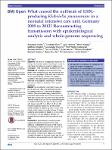What caused the outbreak of ESBL-producing Klebsiella pneumoniae in a neonatal intensive care unit, Germany 2009 to 2012? Reconstructing transmission with epidemiological analysis and whole-genome sequencing
Haller, Sebastian
Eller, Christoph
Hermes, Julia
Kaase, Martin
Steglich, Matthias
Radonić, Aleksandar
Dabrowski, Piotr Wojtek
Nitsche, Andreas
Pfeifer, Yvonne
Werner, Guido
Wunderle, Werner
Velasco, Edward
Sin, Muna Abu
Eckmanns, Tim
Nübel, Ulrich
Objective: We aimed to retrospectively reconstruct the timing of transmission events and pathways in order to understand why extensive preventive measures and investigations were not sufficient to prevent new cases. Methods: We extracted available information from patient charts to describe cases and to compare them to the normal population of the ward. We conducted a cohort study to identify risk factors for pathogen acquisition. We sequenced the available isolates to determine the phylogenetic relatedness of Klebsiella pneumoniae isolates on the basis of their genome sequences. Results: The investigation comprises 37 cases and the 10 cases with ESBL (extended-spectrum beta-lactamase)-producing K. pneumoniae bloodstream infection. Descriptive epidemiology indicated that a continuous transmission from person to person was most likely. Results from the cohort study showed that ‘frequent manipulation’ (a proxy for increased exposure to medical procedures) was significantly associated with being a case (RR 1.44, 95% CI 1.02 to 2.19). Genome sequences revealed that all 48 bacterial isolates available for sequencing from 31 cases were closely related (maximum genetic distance, 12 single nucleotide polymorphisms). Based on our calculation of evolutionary rate and sequence diversity, we estimate that the outbreak strain was endemic since 2008. Conclusions: Epidemiological and phylogenetic analyses consistently indicated that there were additional, undiscovered cases prior to the onset of microbiological screening and that the spread of the pathogen remained undetected over several years, driven predominantly by person-to-person transmission. Whole-genome sequencing provided valuable information on the onset, course and size of the outbreak, and on possible ways of transmission.
Dateien zu dieser Publikation
Keine Lizenzangabe
Verwandte Publikationen
Anzeige der Publikationen mit ähnlichem Titel, Autor, Urheber und Thema.
-
2015-06-11ZeitschriftenartikelThree Dimensional Checkerboard Synergy Analysis of Colistin, Meropenem, Tigecycline against Multidrug-Resistant Clinical Klebsiella pneumonia Isolates Stein, Claudia; Makarewic, Oliwia; Bohnert, Jürgen A.; Pfeifer, Yvonne; Kesselmeier, Miriam; Hagel, Stefan; Pletz, Mathias W.The spread of carbapenem-non-susceptible Klebsiella pneumoniae strains bearing different resistance determinants is a rising problem worldwide. Especially infections with KPC (Klebsiella pneumoniae carbapenemase) - producers ...
-
2015-07-23ZeitschriftenartikelDraft Genome Sequences of Klebsiella oxytoca Isolates Originating from a Highly Contaminated Liquid Hand Soap Product Hammerl, J. A.; Lasch, Peter; Nitsche, Andreas; Dabrowski, Piotr Wojtek; Hahmann, H.; Wicke, Amal; Kleta, S.; Dahouk, Sascha Al; Dieckmann, R.In 2013, contaminated liquid soap was detected by routine microbiological monitoring of consumer products through state health authorities. Because of its high load of Klebsiella oxytoca, the liquid soap was notified via ...
-
2015-07-09ZeitschriftenartikelComplete Genome Sequence of a CTX-M-15-Producing Klebsiella pneumoniae Outbreak Strain from Multilocus Sequence Type 514 Becker, Laura; Bunk, Boyke; Eller, Christoph; Steglich, Matthias; Pfeifer, Yvonne; Werner, Guido; Nübel, UlrichWe report here the genome sequence of a multidrug-resistant Klebsiella pneumoniae strain, which caused an outbreak in a neonatal ward in 2011. The genome consists of a single chromosome (5,278 kb) and three plasmids (362 ...

